Overview
As a parent, recognizing the main symptoms of autism can be both daunting and crucial. Limited eye contact, lack of response to their name, difficulties in social interactions, repetitive behaviors, and unusual sensory responses are key indicators to be aware of. Understanding these signs is the first step in a journey towards support and growth.
Early identification of these symptoms is vital for timely intervention. Research shows that when support is provided early, it significantly enhances social skills and communication outcomes for children on the spectrum. Imagine the positive changes early intervention can bring to your child's life—improvements in their ability to connect with others and express themselves.
If you suspect that your child may be exhibiting these symptoms, don’t hesitate to reach out for help. There are numerous resources and support networks available that can guide you through this process. Together, we can foster a nurturing environment that helps your child thrive.
Introduction
In a world where understanding autism is more critical than ever, ASD Media stands out as a vital resource, bridging the gap between knowledge and support for families and professionals alike. This platform offers a rich array of articles, guides, and community initiatives that empower individuals to identify and manage autism symptoms effectively. As research continues to evolve, particularly regarding the diverse manifestations of autism across various populations, the need for informed advocacy and early intervention becomes paramount.
Recognizing key signs in children and understanding the nuances of adult autism can be challenging. The journey through this spectrum is filled with both challenges and triumphs. By fostering a collaborative environment, ASD Media enhances awareness and equips caregivers with the tools necessary to navigate the complexities of autism. This ensures that every individual receives the support they deserve. We invite you to explore the resources available and join the conversation, as together we can make a meaningful difference in the lives of those affected by autism.
About ASD Media: Essential Resources for Understanding Autism Symptoms
ASD Media serves as a vital resource for enhancing the understanding of the symptom of autism. It offers a diverse array of articles, guides, and community support tailored for both parents and professionals. This platform not only aids in identifying and managing developmental disorders effectively but also fosters a collaborative environment where individuals can share their experiences and learn from one another. By subscribing to their newsletter, users can access the latest research and strategies, ensuring they stay informed about current trends and developments in the field, including the most recent findings on symptoms in 2025.
This commitment to education is crucial, especially when considering that the average cost of therapeutic behavioral services in the U.S. is $175.44. This reality underscores the importance of informed decision-making for families navigating these challenges. Moreover, case studies such as 'Mesa Leads the Way in Accessibility for Individuals with Developmental Disorders' showcase effective community initiatives that enhance support and inclusivity for those with developmental disorders. These examples highlight the positive impact of cooperative efforts in raising awareness and improving outcomes.
As emphasized by Yolande Loftus, recent studies reveal that ASD prevalence varies significantly among different racial groups, with Hispanic youth experiencing a rate 1.8 times higher than non-Hispanic White youth. This finding underscores the importance of recognizing the symptom of autism across diverse populations. Furthermore, social workers play a crucial role in educating parents on how to plan for their children's futures, breaking down the process into manageable steps. This aligns perfectly with ASD Media's mission to empower families, ensuring they have the tools and knowledge necessary to support their loved ones.
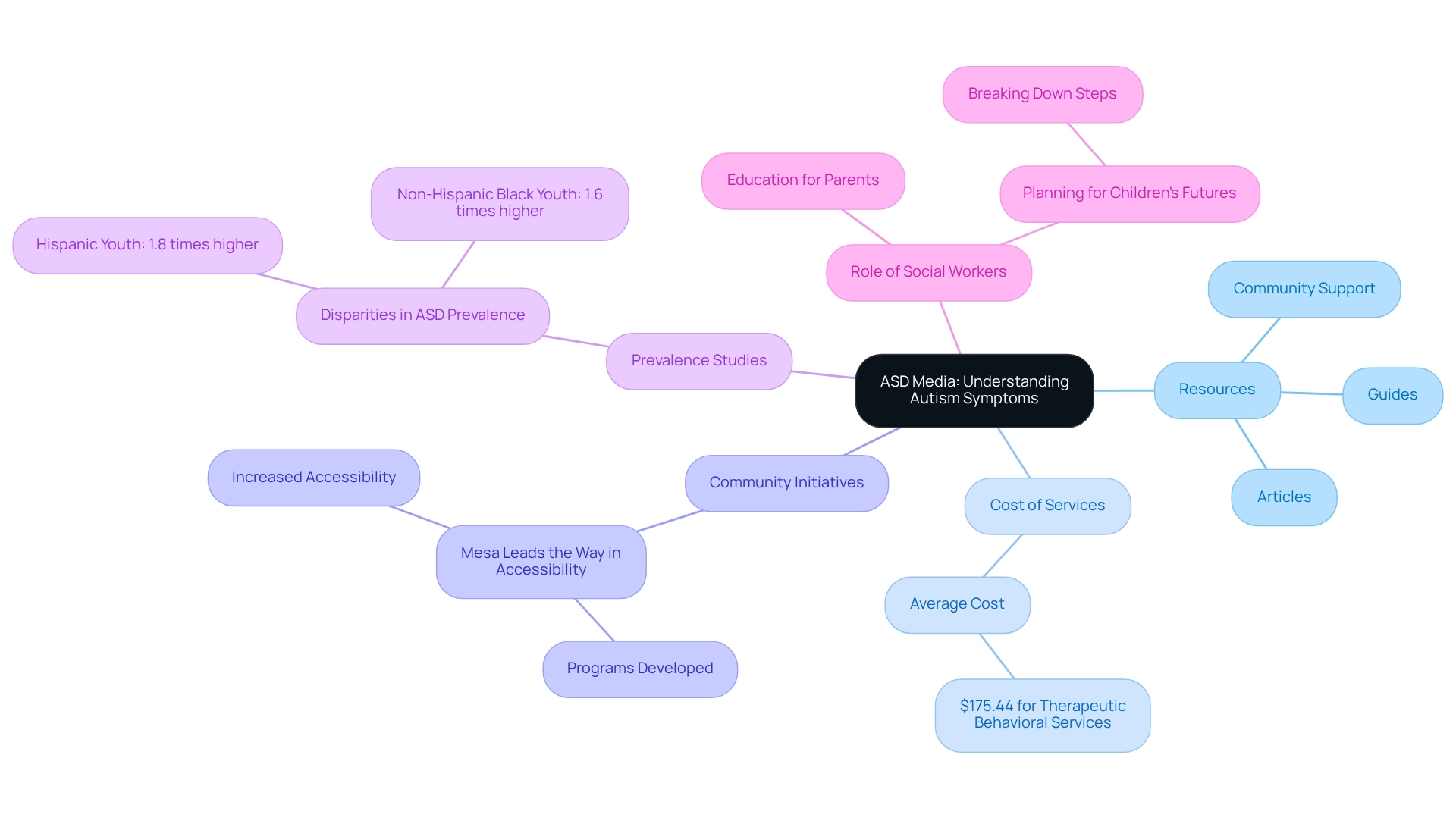
Signs of Autism in Children: Key Indicators to Watch For
Recognizing the symptom of autism in children is crucial for early intervention and effective management of the condition. Limited eye contact, seen in about 40% of individuals with autism, and a lack of response to their name are key indicators that can be considered a symptom of autism that parents should be aware of. Moreover, difficulties in engaging with peers and adults can present as challenges in starting or maintaining conversations. Parents should also watch for repetitive behaviors, such as hand-flapping, rocking, or organizing toys, as these are common symptoms of autism. Unusual reactions to sensory stimuli, such as overreacting to sounds or textures, can be a symptom of autism, further emphasizing the importance of evaluation.
Research shows that early identification of these symptoms can lead to significantly better outcomes. For instance, a study revealed that children who received early support demonstrated remarkable improvements in social skills and communication. According to Maenner MJ, the prevalence and characteristics of spectrum disorder in youth aged 8 years highlight the necessity of awareness for effective management. In Arizona, the prevalence of AI/AN spectrum disorder in 2020 was 26.8 per 1,000, underscoring the importance of recognizing these indicators across diverse communities.
Pediatricians stress that guardians should be proactive in observing these behaviors, as timely intervention can enhance long-term outcomes. As noted in the case study 'Future Predictions for Autism Awareness and Education,' caregivers often express concerns about planning for their children's futures, reinforcing the need for better support from social workers in this area. As our understanding of ASD grows, it is essential for caregivers to educate themselves about the symptom of autism to ensure their children receive the necessary assistance as early as possible.
ASD Media is dedicated to empowering parents and professionals with effective strategies for managing challenging behaviors and fostering social skills development.
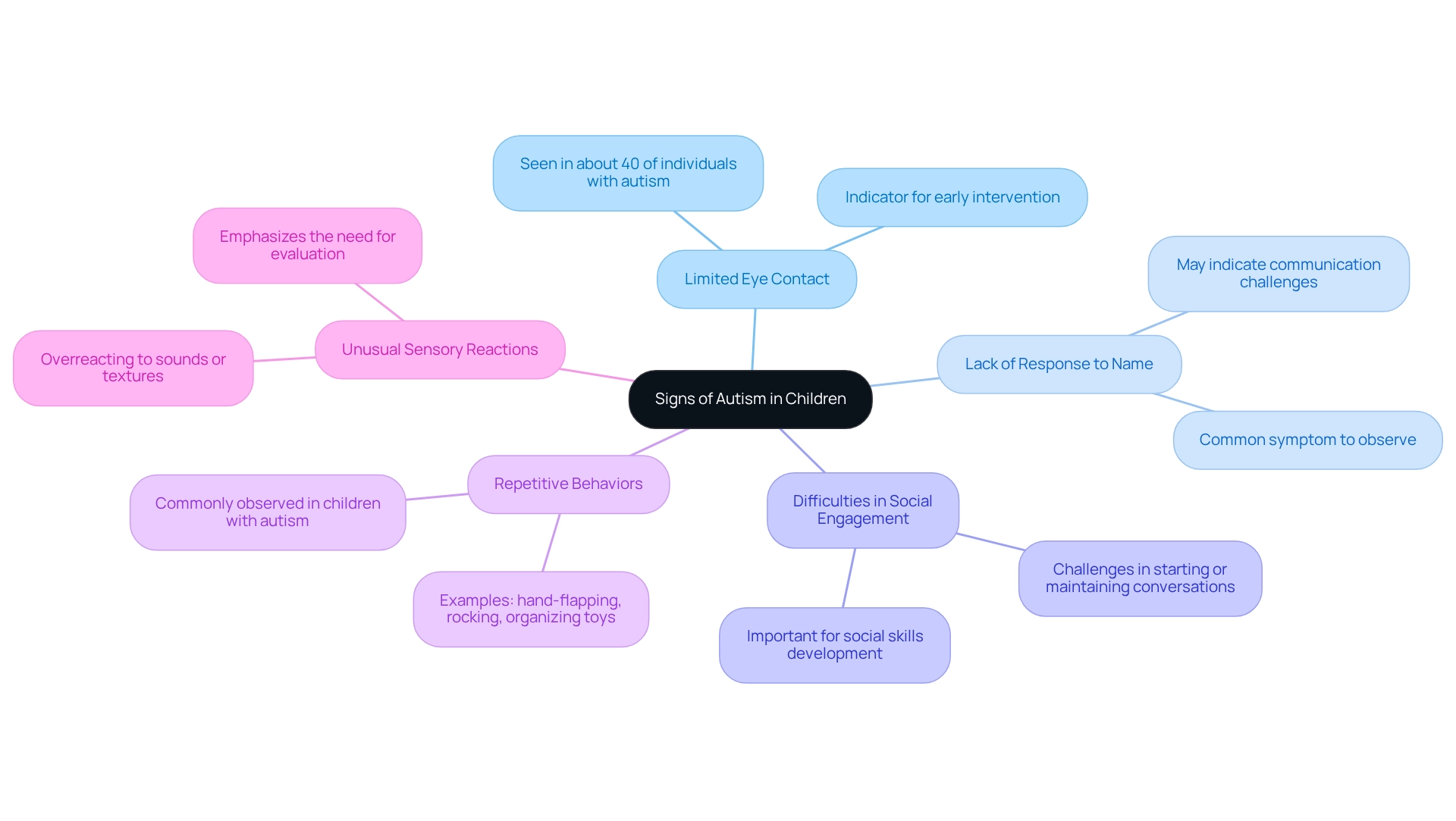
Symptoms of Autism in Adults: Recognizing Signs Beyond Childhood
In adults, a symptom of autism spectrum conditions can manifest in various ways, particularly through challenges in social interactions. Many individuals on the spectrum may find it difficult to grasp social cues, and this can be a symptom of autism that hinders their ability to sustain conversations. Additionally, common traits that are considered a symptom of autism include repetitive behaviors and intense interests in specific subjects.
Recent statistics reveal that the estimated prevalence of autism spectrum condition (ASD) among adults aged 18-84 in the U.S. stands at approximately 0.60%. This figure highlights the importance of recognizing the symptom of autism in an expanding demographic, especially as the rise in autism-related diagnoses among young adults indicates a shift in focus towards this group.
As awareness grows, it is crucial to adapt our understanding and support strategies. Creating encouraging environments that address the unique needs of adults on the spectrum not only improves their well-being but also fosters a more inclusive community. Experts emphasize that as screening methods evolve, our understanding of neurodevelopmental disorders in adults will continue to progress.
In fact, 80% of Prosper Health's expert clinicians identify as neurodivergent or have a close connection with neurodivergence, underscoring the necessity for tailored support. ASD Media notes, "As screening processes for adults enhance and we deepen our understanding of the condition, the estimate will likely change to better reflect the true number of autistic adults in the nation."
This evolving perspective is vital for recognizing and supporting those who may exhibit a symptom of autism and have previously gone undiagnosed.
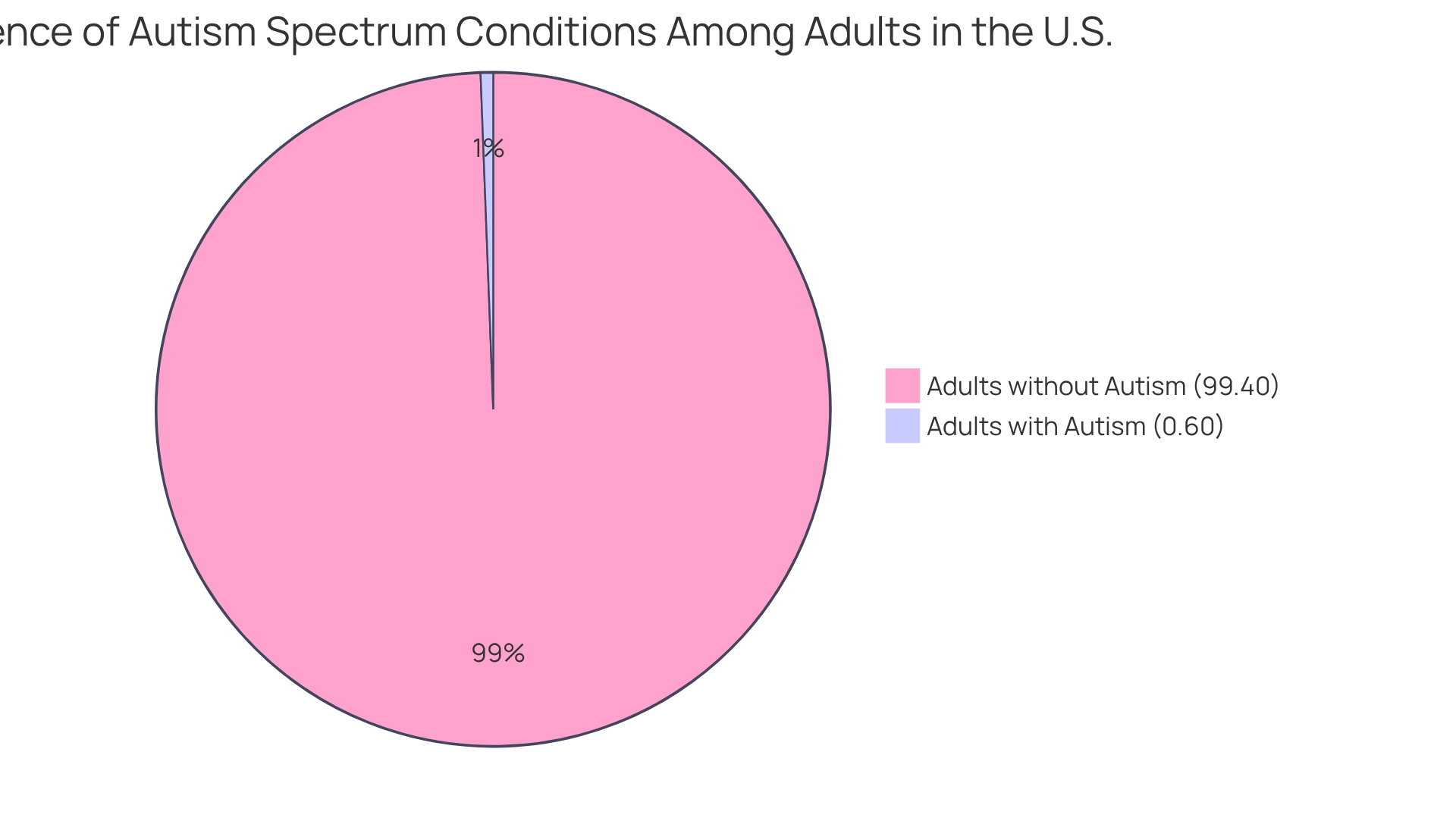
Early Intervention: Critical Steps for Managing Autism Symptoms
Timely support techniques, particularly Applied Behavior Analysis (ABA) therapy, play a crucial role in enhancing communication, social skills, and behavioral outcomes for children with developmental disorders. Research shows that early signs of these conditions can include a symptom of autism, such as diminished social attention and poor eye contact, and can be reliably diagnosed by age two, with many indicators observable as early as the first year of life. Recognizing these signs promptly is vital for timely diagnosis and intervention, leading to significantly improved outcomes and a better quality of life for children.
Experts in the field highlight that ABA therapy is a scientifically validated approach. It focuses on breaking down complex skills into smaller, manageable steps while reinforcing positive behavior with rewards. This method has shown positive results in early assistance, making it an invaluable resource for parents navigating the challenges of developmental disorders. By prioritizing early support strategies, families can unlock their children's potential and foster a nurturing environment for growth, particularly when parents notice a symptom of autism, as they are strongly encouraged to seek assessments and implement personalized strategies. Engaging with professionals who specialize in autism equips families with the necessary tools to effectively support their child's development. The long-term benefits of early action are well-documented, showcasing sustained improvements in skills and significant economic implications for families and society. For example, early intervention can reduce the need for special education services and improve employment outcomes, ultimately benefiting both the individual and the community.
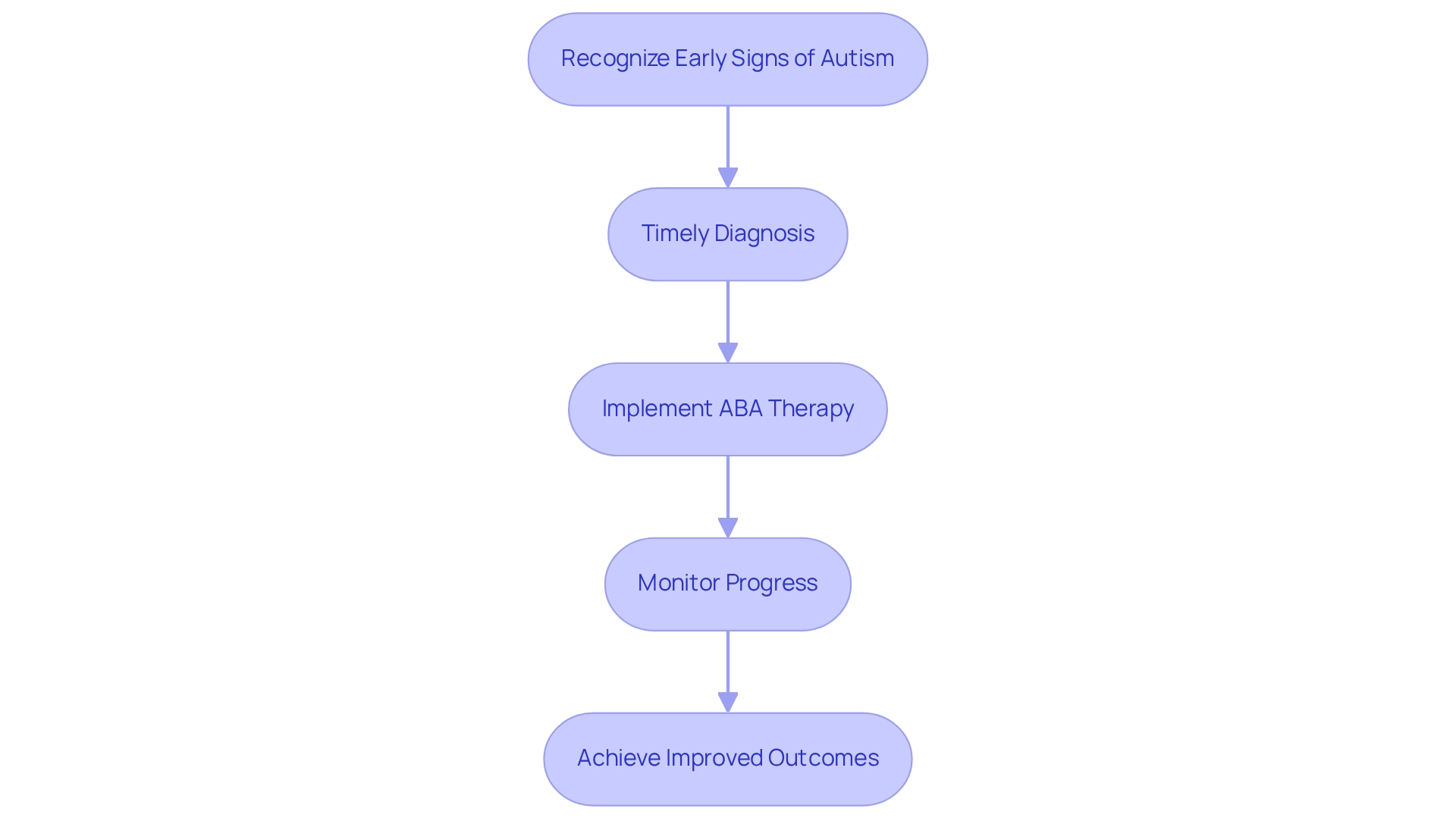
Sensory Sensitivities: Understanding Autism's Impact on Daily Life
Sensory sensitivities are a symptom of autism and a common experience for many individuals with developmental differences, often manifesting as either over-responsiveness or under-responsiveness to sensory stimuli. For instance, a young person may react strongly to loud sounds or bright lights, which can lead to anxiety or even meltdowns. These reactions underscore the importance of understanding sensory processing issues, as they significantly impact daily life and overall well-being.
Research shows that sensory sensitivities can influence adaptive functioning over time, highlighting the need for tailored support strategies. The Short Sensory Profile, a widely used assessment tool, boasts a reliability of 0.90 and a discriminant validity exceeding 95%, demonstrating its effectiveness in identifying sensory challenges. Moreover, VMA scores have been positively linked with VABS scores (β = 0.65; CI = 0.36–0.94), indicating a significant relationship between sensory sensitivities and adaptive functioning.
In 2025, the focus on sensory sensitivities in individuals on the spectrum has gained momentum, with studies revealing that these issues may share genetic factors with conditions such as anxiety and ADHD. This growing body of research encourages further exploration into sensory processing, an area that has historically been underexamined. Importantly, research aims to outline the developmental path of sensory symptoms in young individuals with developmental disorders, emphasizing the significance of early intervention.
Occupational therapists advocate for proactive approaches to address sensory sensitivities, including creating sensory-friendly environments and implementing customized sensory plans. These tailored strategies can help reduce discomfort and enhance participation in everyday tasks, ultimately improving the quality of life for individuals with the symptom of autism. Case studies illustrate effective methods that have led to positive outcomes, reinforcing the idea that understanding and addressing sensory sensitivities is crucial for fostering a supportive environment. For example, specific interventions have shown the ability to significantly reduce anxiety and enhance adaptive skills in children with developmental disorders. By prioritizing sensory needs, caregivers and professionals can empower individuals on the spectrum to navigate their world with greater comfort and confidence.
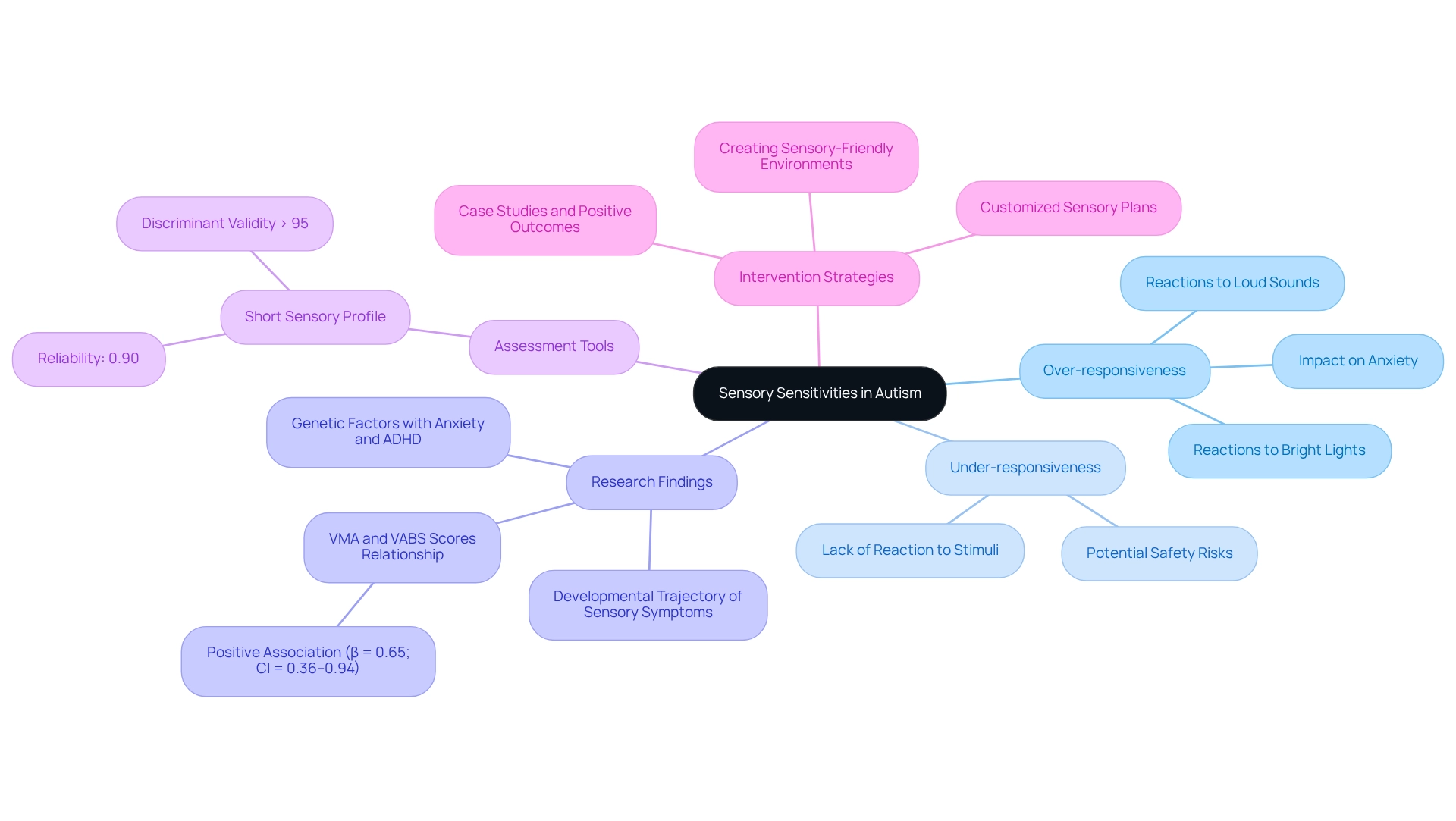
Social Communication Challenges: Key Symptoms of Autism
Individuals on the spectrum often face considerable challenges in social communication. They may struggle with interpreting nonverbal cues, maintaining eye contact, and engaging in reciprocal conversations. These difficulties can lead to feelings of social isolation and misunderstandings, which in turn affect relationships and overall quality of life. However, it is encouraging to note that recent statistics reveal nearly 25% of school-age autistic children are thriving across all developmental areas. This underscores the potential for positive outcomes through effective interventions, as highlighted in the case study titled "Positive Developmental Outcomes for Autistic Children."
To support individuals with autism, guardians and caregivers can adopt several nurturing strategies:
- Modeling effective communication techniques is essential; for example, using clear, concise language and visual supports can greatly enhance understanding.
- Providing structured opportunities for social interaction—such as playdates or group activities—can be instrumental in fostering the development of essential social skills.
- It is beneficial for parents to break these strategies into manageable steps, making them easier to incorporate into daily routines.
Experts emphasize the critical role of early intervention in addressing social communication challenges. Speech therapists often recommend tailored approaches that focus on enhancing communication skills through engaging activities. As Yolande Loftus highlights, disparities in ASD prevalence underscore the need for targeted support across various demographic groups. Case studies reveal that young individuals who receive focused assistance show significant progress in navigating social situations, reinforcing the notion that favorable developmental outcomes are within reach.
Ultimately, by understanding these challenges and implementing supportive strategies in manageable steps, caregivers can profoundly impact their child's social communication abilities. This paves the way for more fulfilling relationships and interactions, creating a brighter future for their loved ones.
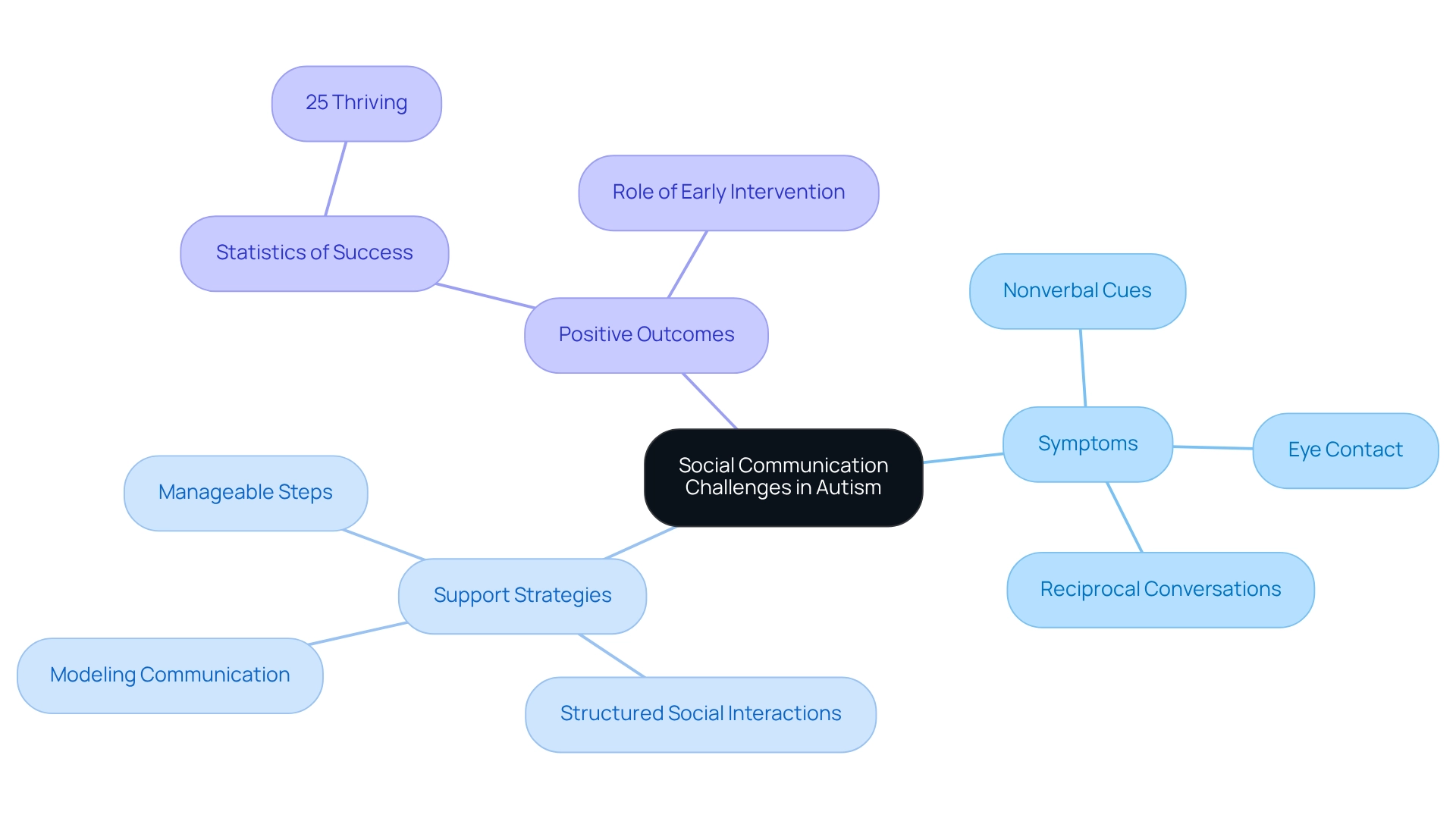
Repetitive Behaviors: Identifying Autism Symptoms in Daily Activities
Repetitive behaviors, such as hand-flapping, rocking, and insistence on routines, are common among individuals with autism. These actions often serve as coping mechanisms for anxiety or sensory overload, making it essential for parents and caregivers to understand them. Recognizing these behaviors can reveal underlying emotional states or needs, allowing for better support. Research from the ADDM Network highlights that early intervention programs can significantly improve outcomes for youth exhibiting these behaviors, underscoring the importance of timely assistance.
Behavioral therapists stress that understanding the function of these repetitive actions is key to managing them effectively. For example, a child might engage in hand-flapping as a self-soothing technique during stressful moments. By identifying these behaviors, caregivers can implement alternative strategies that foster emotional regulation and alleviate anxiety.
A case study titled "Challenges Faced by Individuals with Autism" illustrates how repetitive behaviors can impact daily life, including communication difficulties and social interaction issues. Understanding these challenges enables caregivers and professionals to tailor their approaches, creating an environment where individuals can thrive.
As we look ahead to 2025, the prevalence of repetitive behaviors continues to be a significant focus within the neurodiversity community, with ongoing research shedding light on their functions. As Debra Muzikar wisely states, "Autism is not a roadblock but a detour to a different destination, filled with unique opportunities." Staying informed and utilizing effective strategies empowers parents to better support their children in navigating these behaviors, ultimately enhancing their overall well-being.
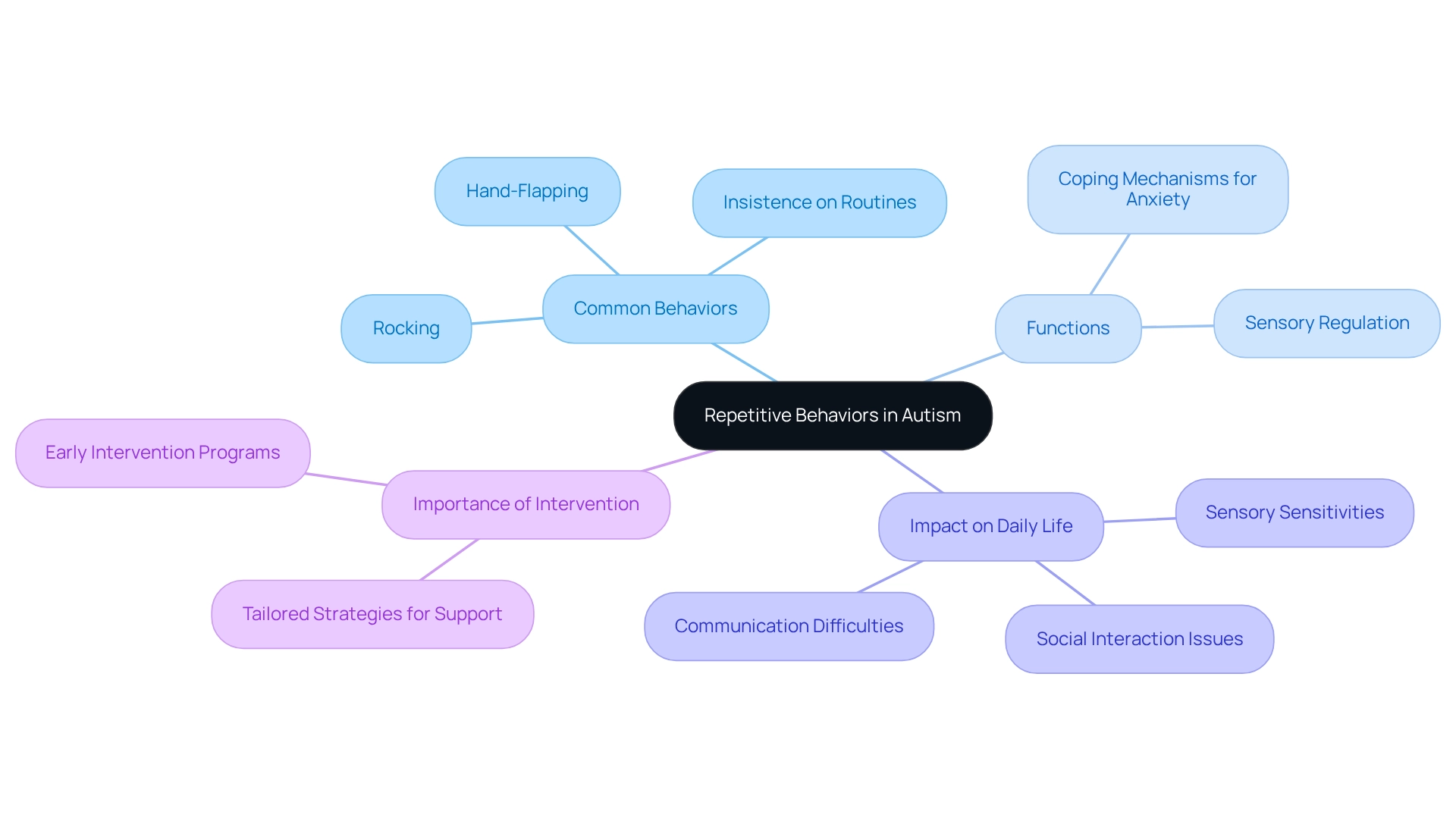
Emotional and Behavioral Signs: Recognizing Autism Symptoms
Emotional regulation can be a significant challenge for individuals on the spectrum, often being a symptom of autism that manifests as outbursts or withdrawal in stressful situations. Many find it difficult to recognize and express their emotions, complicating their interactions with others. Research indicates that individuals with autism are less likely to employ adaptive emotional regulation techniques, which correlates with heightened emotional and behavioral challenges. This underscores the need for targeted interventions.
Parents are pivotal in fostering emotional development by teaching effective coping strategies and nurturing a safe environment for emotional expression. By cultivating resilience and emotional well-being, parents can help their children navigate daily challenges more effectively. Experts stress the importance of recognizing these emotional and behavioral signs, as they are crucial for promoting positive outcomes for individuals, since these can be a symptom of autism.
As we look ahead to 2025, the focus on emotional regulation challenges remains vital. Ongoing studies funded by Babeș-Bolyai University are advocating for innovative approaches, such as wearable devices for monitoring physiological states, which have received ethical approval from the Institutional Ethics Committee. These advancements could provide valuable insights into emotional dysregulation, particularly for those scoring above 2 standard deviations on the CBCL-AAA profile.
Moreover, findings from the case study titled 'Adaptive vs. Maladaptive Emotional Regulation Strategies' reveal that individuals with ASD are less likely to utilize adaptive strategies, reinforcing the need for targeted interventions. By staying informed and proactive, parents can profoundly impact their children's emotional development and overall quality of life.
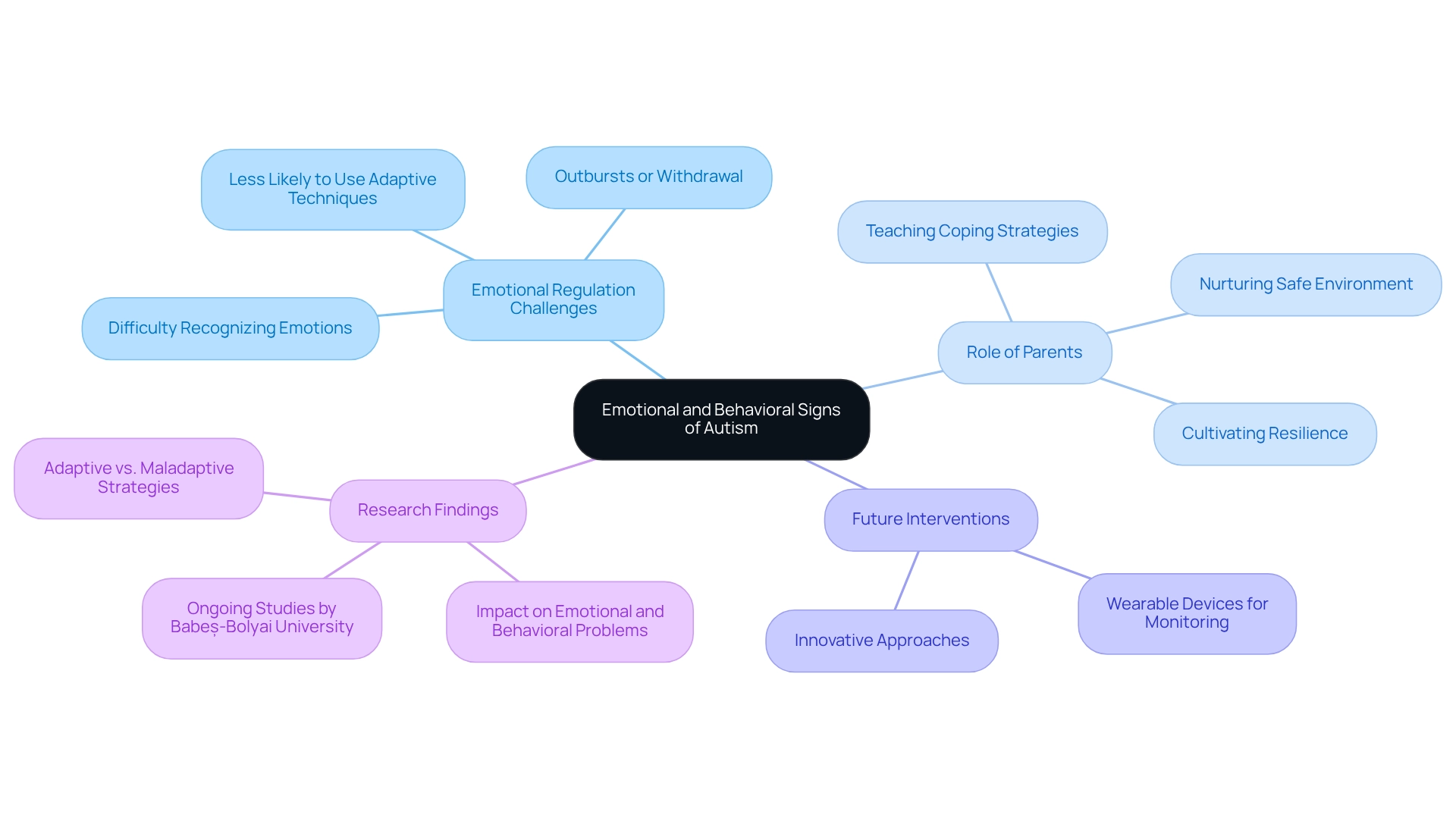
Gastrointestinal Issues: Overlooked Symptoms of Autism
Gastrointestinal problems are a common concern for many families with children who have developmental disorders. Symptoms such as constipation, diarrhea, and abdominal pain can be distressing, not only for the child but also for their parents. Research indicates that between 50% to 80% of youths with developmental disorders experience sleep issues, which can be exacerbated by gastrointestinal discomfort, as highlighted by Julie Rasmuson, Director of Student Accessibility Services. These health challenges can significantly impact both physical well-being and behavioral outcomes.
As a caring parent, it’s crucial to closely monitor your child's gastrointestinal health and seek guidance from healthcare providers to implement effective interventions. Evidence-based, parent-led strategies, like those offered by MEAL PlanR, can specifically target gastrointestinal issues, leading to meaningful improvements in behavior and overall quality of life. Understanding that autism prevalence varies across different countries emphasizes the need to consider cultural and environmental factors when addressing these health challenges.
By prioritizing gastrointestinal health, you can help mitigate behavioral challenges and enhance your child's developmental journey. To take actionable steps, keep a detailed record of your child's gastrointestinal symptoms, and discuss these observations with your healthcare provider. Together, you can tailor interventions that best suit your child's unique needs, fostering a supportive environment for their growth and development.
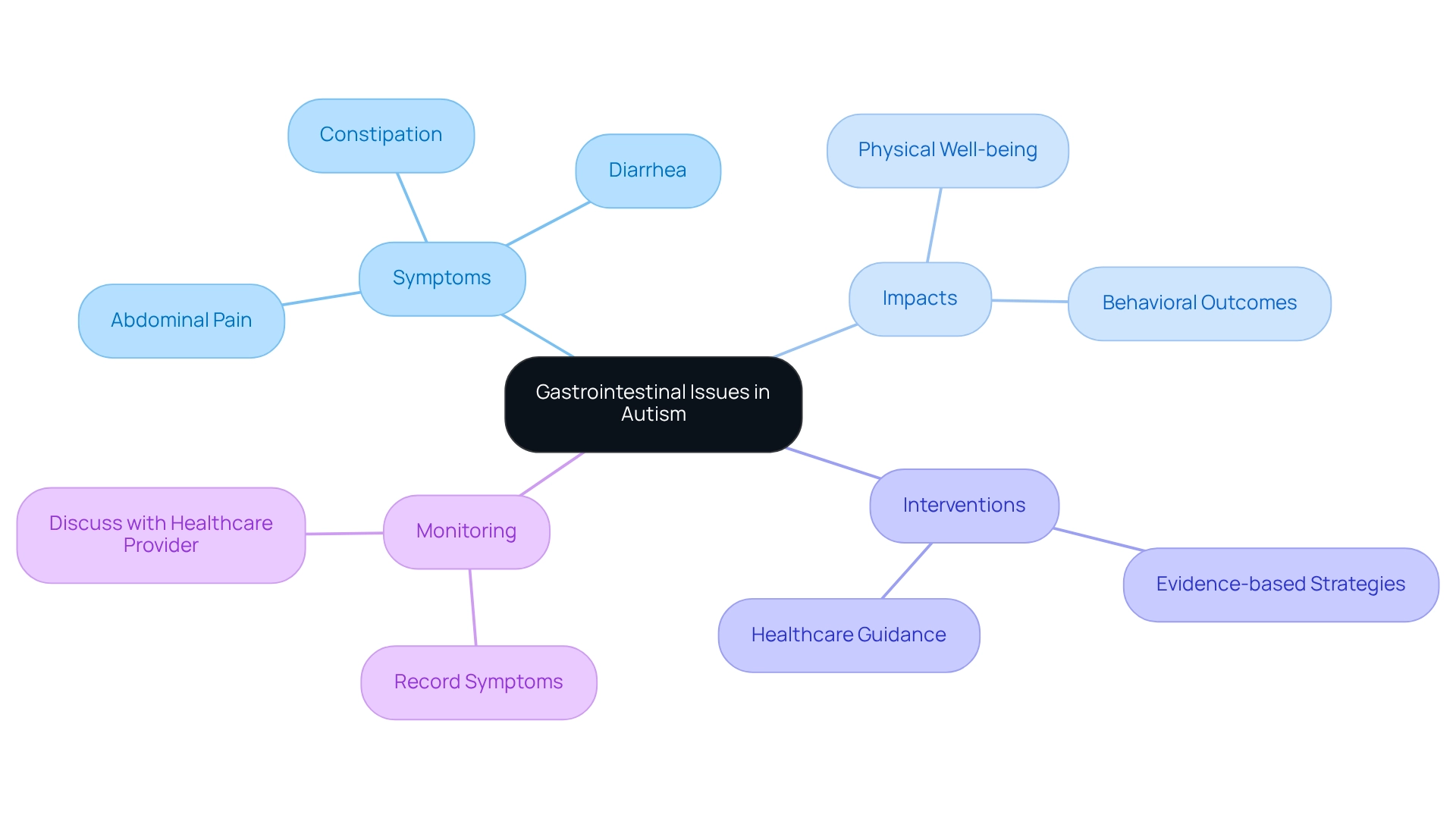
Continuous Education: Staying Informed About Autism Symptoms
Staying informed about the latest research and developments in neurodevelopmental disorders is crucial for both parents and professionals. Resources like ASD Media's newsletter, workshops, and online courses offer valuable insights into effective strategies for managing the symptom of autism related to these disorders. Ongoing education empowers caregivers to support their children, equipping them with evidence-based methods that significantly enhance the quality of life for individuals on the spectrum. For instance, it's concerning that approximately 8% of autistic students do not complete high school. This statistic highlights the urgent need for informed advocacy and support.
ASD Media provides customized educational materials that help families understand the condition and explore personalized treatment strategies. Moreover, advocates for individuals on the spectrum stress that staying informed cultivates a supportive community, fostering acceptance and understanding in society at large. As Autism Speaks states, "The data can also benefit families, improving awareness of and access to services and support programs in their state."
As the autism community continues to celebrate its unique characteristics, ongoing education remains a cornerstone for caregivers. It ensures they are well-equipped to navigate the complexities of autism management, particularly when addressing any symptom of autism, ultimately making a meaningful difference in the lives of their loved ones. We encourage you to engage with these resources and share your experiences, as together we can build a more informed and compassionate community.
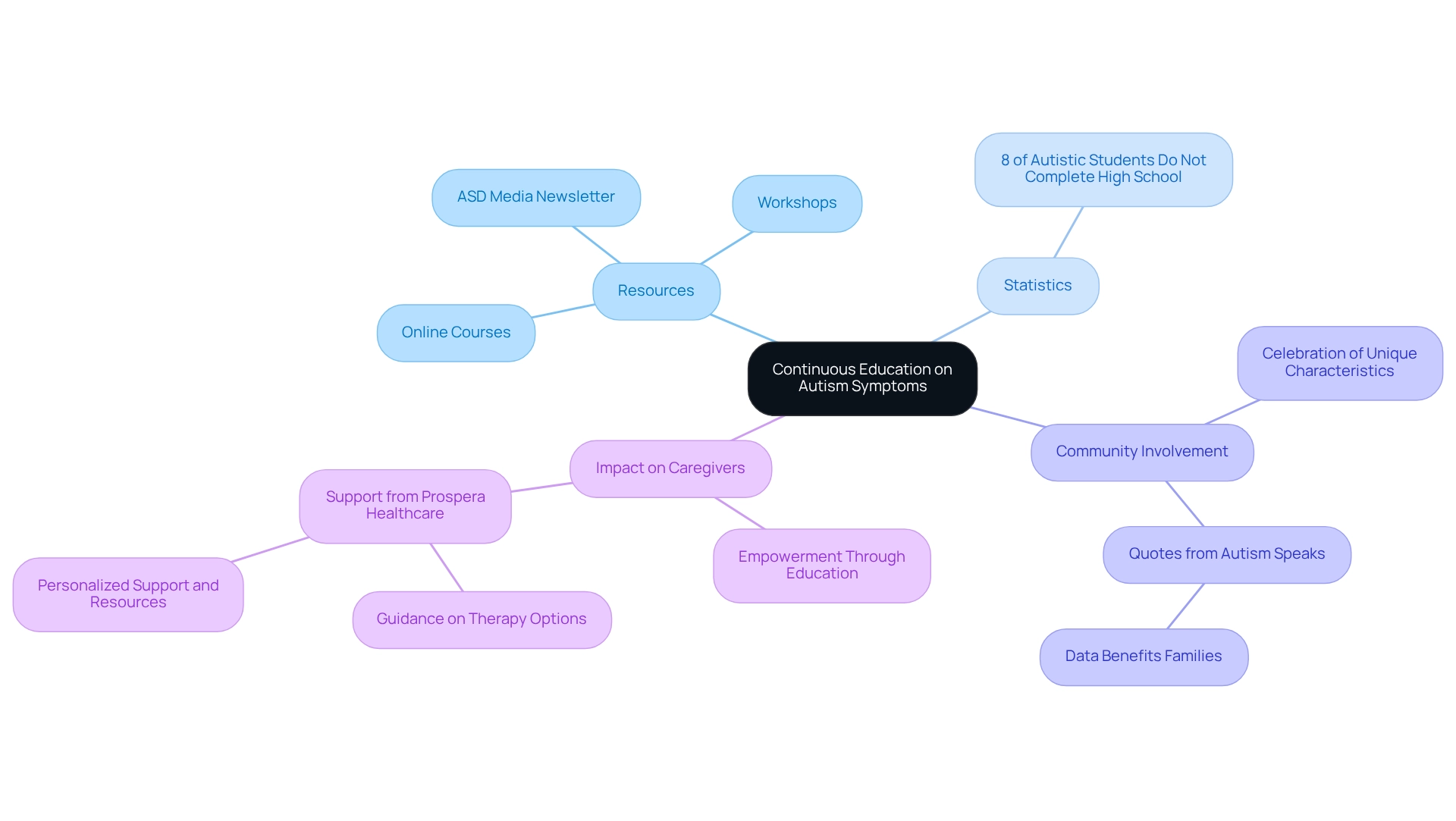
Conclusion
ASD Media stands as a vital resource in the ongoing journey to understand and support individuals affected by autism. It offers a rich collection of articles, guides, and community initiatives that empower both families and professionals to recognize and manage autism symptoms with confidence. The focus on early intervention and education highlights the importance of timely support, which can lead to meaningful improvements in social skills, communication, and overall quality of life.
Recognizing the signs of autism, whether in children or adults, is essential for fostering understanding and facilitating effective interventions. From sensory sensitivities to social communication challenges, the diverse manifestations of autism call for tailored strategies that honor the unique needs of each individual. The insights shared here emphasize the necessity for proactive measures, such as engaging with healthcare professionals and adopting evidence-based practices.
Ultimately, the journey through the autism spectrum is filled with both challenges and opportunities for growth. By prioritizing education and collaboration, the autism community can cultivate a more inclusive environment that not only supports individuals on the spectrum but also enriches the lives of their families and caregivers. Staying informed and involved is key to making a meaningful difference, ensuring that every person affected by autism receives the support they truly deserve. Let us continue this journey together, sharing experiences and resources to uplift one another.
Frequently Asked Questions
What resources does ASD Media provide for understanding autism?
ASD Media offers a diverse array of articles, guides, and community support tailored for both parents and professionals to enhance the understanding of autism symptoms and management of developmental disorders.
How can subscribing to ASD Media's newsletter benefit users?
By subscribing to the newsletter, users can access the latest research and strategies, ensuring they stay informed about current trends and developments in the field, including recent findings on autism symptoms.
Why is early recognition of autism symptoms important?
Early recognition of autism symptoms is crucial for effective intervention and management, leading to significantly better outcomes in social skills and communication.
What are some common symptoms of autism that parents should observe in their children?
Parents should look for limited eye contact, lack of response to their name, difficulties in engaging with peers, repetitive behaviors, and unusual reactions to sensory stimuli.
What is the significance of the statistics regarding autism prevalence among different racial groups?
Recent studies show that ASD prevalence varies significantly among racial groups, with Hispanic youth experiencing a rate 1.8 times higher than non-Hispanic White youth, highlighting the need for awareness across diverse populations.
What role do social workers play in supporting families with autism?
Social workers help educate parents on planning for their children's futures, breaking down the process into manageable steps, which aligns with ASD Media's mission to empower families.
How prevalent is autism among adults in the U.S.?
The estimated prevalence of autism spectrum conditions among adults aged 18-84 in the U.S. is approximately 0.60%, indicating a need for recognition and support within this demographic.
What challenges do adults with autism face in social interactions?
Adults on the autism spectrum may struggle with understanding social cues, sustaining conversations, and may exhibit repetitive behaviors and intense interests in specific subjects.
How does ASD Media contribute to the understanding of autism in adults?
ASD Media emphasizes the importance of adapting support strategies as awareness grows, creating environments that address the unique needs of adults on the spectrum to foster inclusivity and well-being.




